FORWARD FOODING
THE BLOG
From Sea to Sip: Solving the Water Crisis with Desalination

In a world where every drop of water counts, the value of this precious resource cannot be overstated. For decades, desalination has been used especially in arid areas with limited rainfall and snowmelt and depleted groundwater as the main source of freshwater. Amidst the high costs and environmental impacts, innovations have been developed to overcome these hurdles.
According to WWF, the economic use value of water from freshwater ecosystems was estimated at approximately US$58 trillion, equivalent to 60% of global gross GDP. Water is the lifeblood of our planet—nurturing ecosystems, sustaining life, and fueling human progress. Yet, billions of people still struggle to access clean, safe drinking water. As climate change, population growth, and pollution exacerbate the global water crisis, the urgency for innovative solutions has never been more critical.
Enter desalination, a transformative technology that turns the vast, saline oceans into a sustainable source of freshwater. More than 20,000 desalination plants in over 150 countries supply about 300 million people with 71.4 billion gallons of fresh water every day. Out of all desalinated water in the world, 62.3% is used for human consumption, 30.2% by various industries, 4.8% by the energy sector, and 1.8% for agricultural irrigation.
As the demand-supply gap for freshwater widens, can desalination be the key to quenching our insatiable thirst and ensuring a future where everyone has access to this fundamental human right?
In the first of our Water Tech Series, we explore the challenges and promises of desalination technology, and how it could get us towards a more sustainable and water-secure world.
Inside Desalination’s Inner Workings
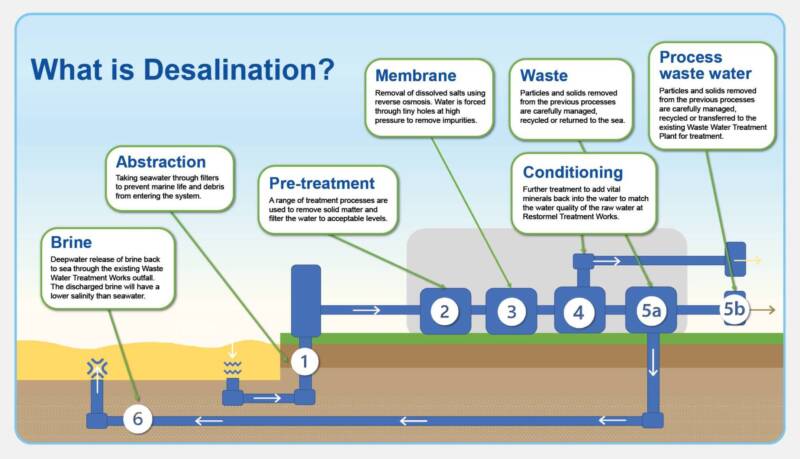
Desalination is the process of removing salts and other impurities from seawater or brackish water to produce fresh water. The two primary methods of desalination are reverse osmosis and thermal distillation, each employing distinct techniques to achieve the same goal.
1. Reverse Osmosis (RO)
Reverse osmosis (RO) is a key technology used in desalination to turn saline water, like seawater, into freshwater. It works by using a special filter, called a semipermeable membrane, to separate water from dissolved salts and impurities.
RO offers several benefits. It operates at lower temperatures, reducing material corrosion compared to other processes. This means it can use more affordable, durable materials instead of costly metal alloys. RO plants have also become more affordable due to advancements in membrane technology and energy recovery devices. These devices capture leftover pressure and turn it into energy, cutting down on costs. RO systems have fewer issues with salt buildup, and by using good filters and regular maintenance, they can avoid clogging problems.
2. Thermal Distillation
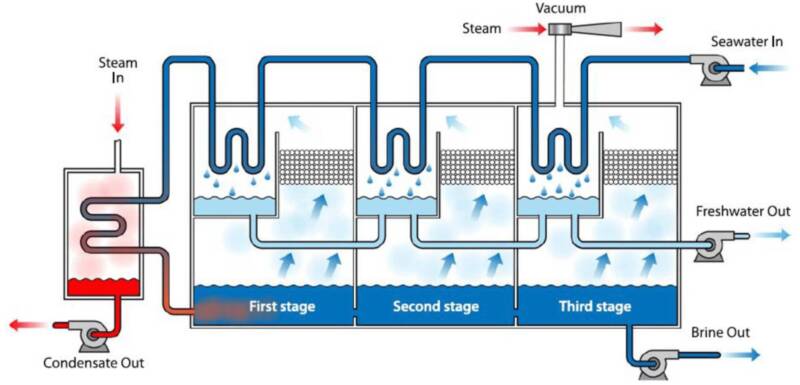
Thermal desalination, also known as distillation, is one of the oldest ways to turn seawater or brackish water into drinking water. It works by heating the water until it evaporates, which separates it from the salts and impurities. The water vapour is then cooled and turned back into liquid, producing freshwater.
Several common methods of thermal desalination follow these basic principles:
Multi-Stage Flash Distillation
Multi-stage flash (MSF) distillation is a widely used method that produces about 64% of the world’s desalinated water, especially in the Arab region, where energy is abundant and inexpensive, as this method requires a lot of thermal and mechanical energy to operate.
MSF distillation is easy to set up and run, with few moving parts. It produces very clean water, but the water needs minerals added back afterwards. Unlike RO, it can handle different types of water better. Running it at high temperatures makes it more efficient, but it can cause salt buildup that clogs the system. Adding more steps helps produce more water, but it also increases costs and complexity. While it uses a lot of energy, this can be managed with systems that make energy use more efficient.
Multi-Effect Distillation
Multi-effect distillation (MED) is one of the oldest large-scale methods for desalinating seawater, currently accounting for about 3.5% of the world’s desalinated water. Known for producing high-quality water and being energy efficient, MED has also been used in industries like sugarcane juice evaporation and salt production.
The MED process works at lower temperatures, which helps prevent damage and buildup in the system. It can handle different types of water, so it’s cheaper to treat and run than reverse osmosis. MED also uses less power than MSF plants and is more efficient at producing fresh water.
Vapor-Compression Evaporation
Vapor-compression evaporation is often used alongside other processes like MED and single-effect vapor compression. This method generates the heat needed to evaporate seawater by compressing vapor, which lowers the boiling point by reducing pressure.
The simplicity and reliability of VC distillation make it ideal for small desalination units, often used in resorts, industries, and drilling sites with limited fresh water. These units typically produce up to 3000 m³ of water per day. Because the process works at low temperatures, it uses less power and helps prevent issues like scale buildup and damage to the tubes.
What’s Propelling the Desalination Boom?
As global freshwater resources become increasingly strained, the need for innovative solutions like desalination has never been more urgent. Once considered an energy-intensive last resort, desalination is now emerging as a critical technology to ensure water security for both current and future generations. Several key drivers are accelerating the adoption and advancement of desalination, making it an essential part of our response to the growing water crisis.
One global challenge driving the need for desalination is water scarcity. According to World Vision, 703 million people do not have access to clean water. That’s 1 in 10 people on the planet. Populations in arid regions close to the sea are most affected by water scarcity, which makes desalination a viable solution to meet freshwater demands.
As the global population expands, governments worldwide are increasingly acknowledging desalination as a vital solution for securing water supplies. Significant investments are being directed toward research and development to enhance desalination technology and reduce its costs. Public-private partnerships are crucial in driving innovation and expanding desalination infrastructure.
Another driver for desalination is the recent advancements in technology, which have significantly lowered costs while enhancing performance and reliability, allowing these technologies to compete with traditional treatment processes in various applications. Innovative commercial strategies and a better understanding of economies of scale have further improved plant economics, leading to the development and construction of larger desalination facilities.
There has been research focused on enhancing the energy efficiency of the desalination process while increasing the utilization of clean energy sources. This shift aims to reduce the environmental footprint associated with traditional energy-intensive desalination methods. Several innovative practices combine desalination with renewable energies, including thermal power from waste heat, solar, wind, wave-powered desalination, and geothermal energy.
The EU is exploring ways to make it a sustainable solution to address the freshwater shortages. Desalination is used in some southern European and Mediterranean countries such as Spain, Cyprus, and Portugal, while Greece and Italy are expanding their projects. With the MENA region having more experience in this technology for decades, we can expect knowledge and tech transfer from them to Europe and other countries.
What’s Stopping Desalination from Going Big?
Despite desalination being a viable solution to water security, especially in arid regions, the process faces several hurdles that hinder its adoption.
High capital and operational costs
Constructing a desalination plant demands significant upfront capital investments, frequently ranging from hundreds of millions to over a billion dollars. As a result, seawater desalination is among the most costly methods of freshwater production.
Some of the key components that contribute to those upfront costs include the size of the facility, desalination technology used, plant location, system design, labor and construction costs, compliance with environmental regulations and permits, and project financing.
The costs of desalination extend beyond the establishment of the plant, with operational expenses generally encompassing the following: energy cost, maintenance and repairs, chemicals for pretreatment, brine disposal cost, monitoring and testing, staffing and other administrative costs.
Environmental concern
Desalination also raises several environmental concerns. One of which is related to brine, a highly concentrated saltwater byproduct that is often discharged back into the ocean. It can significantly increase salinity levels in surrounding waters, which may harm marine life by reducing oxygen levels and disrupting local ecosystems.
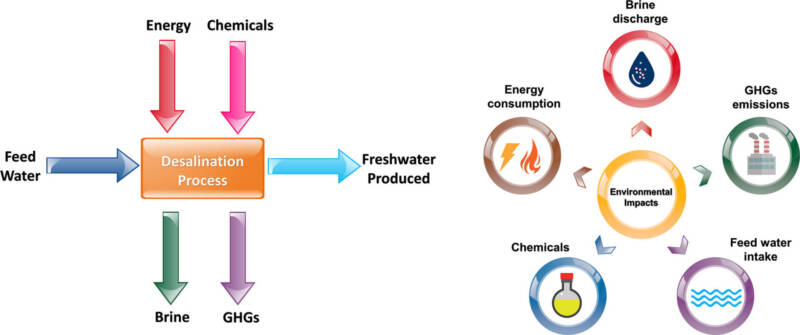
Source: Marine Pollution Bulletin
The process of desalination is also energy-intensive, with most plants relying on fossil fuels, which lead to greenhouse gas emissions and worsen climate change. The high energy requirements can place additional stress on already burdened power grids and increase the overall carbon footprint.
Seawater desalination plants draw in large volumes of seawater to extract fresh water. The intake process can inadvertently harm marine organisms, including plankton, fish larvae, and other small marine creatures. Furthermore, fish and other marine life can get trapped or injured in the intake systems. These unintended consequences can disrupt local ecosystems and have far-reaching effects on the food chain.
Public perception and acceptance issues
Public acceptance of desalination technology is often influenced by familiarity and understanding. Communities with limited knowledge about how desalination works or its benefits may be less inclined to support its implementation. Therefore, building trust through transparent communication about the safety and reliability of desalinated water is crucial.
Additionally, cultural beliefs regarding water sources can shape perceptions, with some communities prioritizing traditional sources and viewing desalinated water as inferior or unnatural.
Concerns about the safety of drinking desalinated water may also arise, particularly among those unfamiliar with the technology. To foster acceptance, it is essential to ensure the public is informed about the rigorous testing and quality standards that govern desalinated water.
Regulatory challenges
Government regulations and policies significantly influence the feasibility and operation of desalination plants, with variations from one location to another often causing delays in project implementation. Compliance with environmental laws, such as the Clean Water Act and the Endangered Species Act, is essential, as desalination facilities must ensure their operations do not harm marine ecosystems or endangered species, leading to increased scrutiny and requirements during the permitting process.
A major regulatory concern is the management of brine discharge; desalination plants must adhere to strict guidelines regarding the salinity and chemical composition of the brine released back into the ocean, as improper disposal can adversely affect marine life.
Additionally, differing state regulations concerning water rights and usage complicate the establishment of desalination facilities. For instance, California’s specific guidelines outlined in its Desalination Planning Handbook introduce another layer of complexity for developers.
The latest update to the Taxonomy Regulation in the EU classifies desalination as a “green” investment under strict conditions, requiring the use of green energy and safe treatment of brine before discharge.
Finally, desalination plants must comply with public health regulations regarding drinking water quality, which also vary by region. Meeting these standards necessitates rigorous testing and monitoring processes that can be resource-intensive, further impacting the operational landscape of desalination projects.
Rising Demand and Investment Growth
The global desalination market is experiencing significant growth, driven by increasing water scarcity and the rising demand for freshwater. Valued at approximately USD 20.32 billion in 2023, the market is projected to reach USD 44.57 billion by 2032, growing at a compound annual growth rate (CAGR) of 9.12% during this period.
The Middle East and Africa hold the largest share of the market, primarily due to acute freshwater shortages, while the Asia-Pacific region is expected to be the fastest-growing market, with a CAGR of 9.92% driven by rapid urbanization and industrialization in countries like China and India. Singapore has established a robust desalination infrastructure to combat its water scarcity challenges, comprising five operational plants. The Victorian Desalination Plant in Australia can supply up to 150 billion liters of fresh water annually and can be expanded to 200 billion liters.
This year, different governments from around the world have announced investing in desalination plants to provide the basic needs of their people:
- The Catalan government invested €2.3B until 2040 to build a new water desalination plant so that Catalonia stops depending on rainwater.
- The Australian government funds a $230M initiative to research and plan a project to provide desalinated water to renewable industries in South Australia.
- The U.S. Department of Energy announced renewed funding of $75M over five years for the National Alliance for Water Innovation to address key barriers in desalination technologies.
- The National Strategic Reference Framework allocated €50M to support desalination projects on various Greek islands.
- The 4th MENA Desalination Projects 2023 Report shows $39.3 billion being invested in regional desalination, with Saudi Arabia and the UAE leading at $14.58 billion and $10.28 billion, respectively.
Players Making Waves in Desalination
Here are a few companies in the water desalination space (Disclaimer: This list of companies is not exhaustive and only features certain products for demoing purposes – the full list is available via the FoodTech Data Navigator):
- Ocean Oasis (Norway) – pioneering a sustainable offshore desalination method through wave power
- Manhat (UAE & Australia) – focuses on patented “natural water distillation” technology for sustainable water solutions for irrigation on in-land and floating farms
- Seawater Greenhouse (UK) – provides a low-cost desalination solution for year-round crop production in some of the world’s hottest and driest regions
- Kona Deep (USA) – provides electrolyte-rich water sourced from the deep ocean waters using reverse osmosis
- Hydratico (Poland) – specializes in providing fast and modular water treatment stations capable of producing drinking water from various sources such as seawater, mining, contaminated rivers, lakes, and even wastewater
- Nanoseen (Poland) – NanoseenX is a new water desalination and purification solution that doesn’t need energy supply or pressure
- Boreal Light (Germany) – designs and manufactures affordable solar water desalination systems for off-grid communities around the globe

Image courtesy of Boreal Light
- PureTec Water Engineering (Israel) – specializes in drinking water filtration and disinfecting treatment
- Yamit (Israel) – manufactures water filtration and water treatment for seawater desalination plants, petrochemical plants, oil drilling platforms, coal mines, steel mills, and municipal drinking and wastewater treatment plants, and irrigation
- Sundrop Farms (Australia) – integrates solar power, electricity generation, freshwater production, and hydroponics to produce high-quality fruits and vegetables on degraded land in arid areas
- Wayout (Sweden) – provides sustainable water production micro-factories that can be operated by anyone using any water source
- Cequesta Water (Israel) – manufactures and markets innovative solutions for sludge dewatering and wastewater treatment systems
- Genius Watter (Italy) – offers a pay-as-you-go water supply with its patented solar reverse osmosis desalination technology and its inclusive approach involving local communities and businesses in projects.
Image courtesy of Sun Drop Farms
Case Studies in GCC
Case Study #1: Saudi Arabia
Saudi Arabia faces significant water scarcity challenges due to its arid climate and limited freshwater resources. To address this issue, the country has made extensive investments in large-scale desalination plants, positioning itself as a global leader in desalination technology. As of recent reports, Saudi Arabia operates several major desalination facilities, including the Ras Al Khair Desalination Plant, which is one of the largest in the world, capable of producing over 1.025 million cubic meters of fresh water per day.
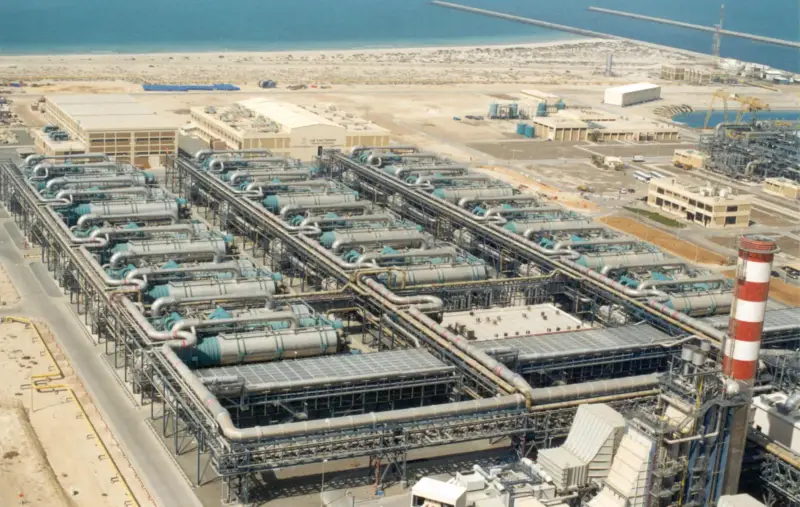
The Saudi government has prioritized desalination as a critical component of its water supply strategy, investing heavily in advanced technologies such as MSF and RO. These technologies enable efficient water production while minimizing energy consumption. The integration of renewable energy sources into these processes is also being explored to further reduce carbon emissions associated with desalination.
The country is working to mitigate these issues by implementing better brine management practices and exploring innovative desalination methods that consume less energy.
The economic implications of these investments are significant, as they not only secure a reliable freshwater supply for domestic use but also support agricultural and industrial growth in the region. Furthermore, with ongoing research and development efforts, Saudi Arabia aims to enhance the efficiency and sustainability of its desalination operations, ensuring long-term water security for its population.
Case Study #2: Taweelah, UAE
The Taweelah Desalination Plant, located in Abu Dhabi, UAE, is recognized as the world’s largest RO seawater desalination facility, with a production capacity of 909,200 cubic meters per day (approximately 200 million imperial gallons per day).
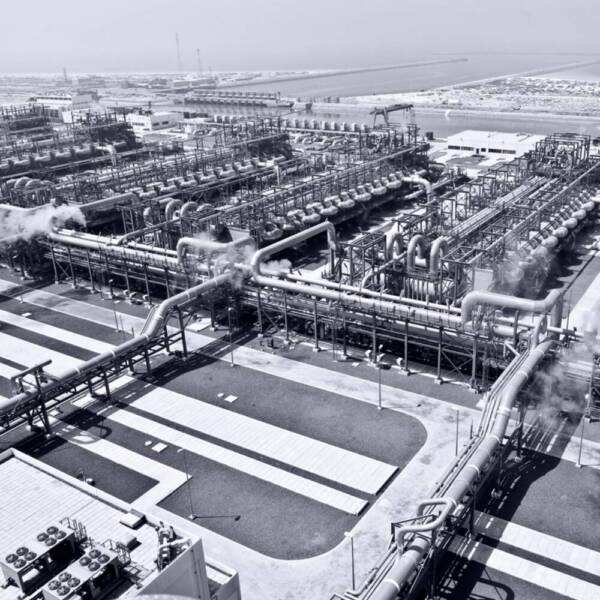
Officially handed over in 2024 after successful testing, the plant is integral to supplying fresh water to Abu Dhabi’s population of around 4.5 million residents. It features a significant integration of renewable energy, including a 70 MWp solar photovoltaic field, which enhances its sustainability by reducing reliance on fossil fuels.
The facility is part of the Al Taweelah Power and Desalination Complex, which also includes other power generation plants like Taweelah A1 and Taweelah B. The Taweelah RO plant is operated by a partnership that includes the Abu Dhabi National Energy Company, Mubadala Investment Company, and ACWA Power, and it has been designed to meet stringent drinking water quality standards mandated by the Emirate of Abu Dhabi.
This investment aligns with the UAE’s broader strategy to enhance water security and promote sustainable infrastructure development in response to growing water demand and environmental concerns.
Charting the Future of Desalination
The future of desalination will likely hinge on innovation, using renewable energy to power desalination plants, optimizing brine management strategies to minimize ecological harm, and integrating smarter designs to reduce costs. Ultimately, the question isn’t whether desalination is part of our water future, but how can we make it work for everyone where freshwater is a right, not a privilege.
Learn more about desalination, water technology, and other areas of FoodTech through our Food Data Navigator. Book a free demo today!
Forward Fooding is the world’s first collaborative platform for the Food & Beverage industry via FoodTech Data Intelligence and Corporate-Startup Collaboration – Learn more about our Consultancy and Scouting Services and our Startup Network.
Follow us
Sponsored Articles
9 July 2025
Forward Fooding celebrates the selection of 12 pioneering startups for the inaugural pladis Accelerator Programme. From water lily popcorn to sugar-converting enzymes, these innovations represent the future of snacking, addressing obesity, sustainability, and personalized nutrition through cutting-edge food technology.
21 March 2025
Tim Ingmire, VP of Global Innovation & Technology at pladis, discusses how the snacking giant is supporting early-stage startups in foodtech, health, and sustainability through their accelerator program. Learn about their focus on personalized nutrition, functional foods, and future ingredients to bring innovative, delicious products to consumers worldwide.
8 February 2024
Future Food-Tech returns to San Francisco on March 21-22 Over 1,700 food-tech leaders, from CPG brands, retailers, ingredient providers, [...]
1 February 2023
The 4th edition of FoodTech 500 is taking off and we are excited to partner with NEOM for the third consecutive year to support the best international AgriFoodTech entrepreneurs.
10 February 2022
One of the elements we enjoy the most here at Forward Fooding about working with AgriFoodTech startups is being [...]






